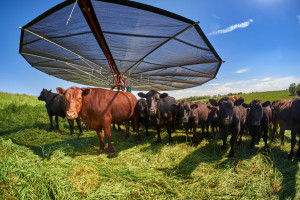For beef and dairy farms, crop fertility is ranked as a leading expense, second to the cost of the land. Rotational grazing practices address the pasture fertility issue, moving animals from paddock to paddock every three days. Through this practice, the animals return nutrients to the pasture by grazing, drinking water and depositing the nutrients back on the paddock. A blazing hot sun presents challenges to rotational grazing practices.
“The issue then is not the addition of nutrients, it’s the distribution of nutrients,” explains Wisconsin beef farmer and managed grazer Jim Munsch. “There are university studies that say without shade, most of the nutrients tend to gravitate toward the water source in the paddock. On a hot day, if you have no shade, the animals will either stand on the highest part of the paddock to get the breeze, or they will stand around the water point.”
If there are trees in a pasture, animals will congregate there and deposit minerals primarily in that area. Munsch adds that “true converts to rotational grazing” considered trees as weeds, for that very reason. On a hot day, animals migrate toward them, resulting in unequal distribution of nutrients in the paddock. The solution, eliminate the trees.
Yet, without shade, the animals suffer, and any farmer raising livestock is concerned about animal comfort. Dairy cows are especially susceptible to heat stress, which impacts production and ultimately the bottom line.
“This in my view is a movable tree,” says Munsch. “Wherever you need nutrients, wherever nutrients have negative migration…a way to get nutrients back into that place is to bring shade there on a sunny day. Shade Haven allows you to move nutrients where you want them. For instance, in my paddock I move cows every day. Here in Wisconsin you can occupy a paddock five or six times during the year. So you have five or six opportunities to move nutrients where you want them.”
The standard time animals stay in a paddock is three days. If all three of those days are sunny, Munsch moves the Shade Haven structure within the paddock daily. “It’s like parking your manure spreader in a place. So if you have a high concentration of animals under there for a good part of the day, you are going to want to move it.”
It’s also wise to move the structure after heavy rains that have saturated the soil. “If the ground is soft, after a couple inches of rain, they are going to beat that little piece of land up pretty bad.”
The nitrogen dilemma
Nitrogen is a typical add to soil by many conventional farmers. Purchasing nitrogen can be expensive. Munsch argues that nitrogen can be added to the soil by encouraging legumes to grow in your pasture. Legumes fix nitrogen from the air. “In fact there is a net positive on nitrogen simply by encouraging legumes to grow on your pasture,” Munsch says. “The economic trade off is legumes for nitrogen, so you don’t have to buy nitrogen, and animals take care of the distribution of nutrients within a paddock for phosphorus and potash and trace minerals, needed to maintain the health of the legumes.”
“On our farm, we have not applied purchased fertilizer to our grazing land in 25 years,” adds Munsch. “This is a product of managing animal distribution and selective out-wintering.”
With dairy cows, who are very susceptible to heat stress, Shade Haven is effective with the distribution of nutrients that keep the pasture healthy and fertile. “The thing that keeps them [dairy cows] in the barn is the shade,” notes Munsch. “By facilitating the animals to spend time in the paddock by providing shade you are moving nutrients out of the barn, out of the lanes, and onto the paddocks.”
